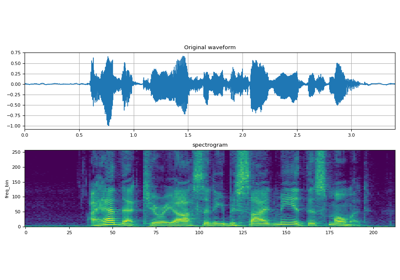梅尔谱图¶
- class torchaudio.transforms.MelSpectrogram(sample_rate: int = 16000, n_fft: int = 400, win_length: ~typing.Optional[int] = None, hop_length: ~typing.Optional[int] = None, f_min: float = 0.0, f_max: ~typing.Optional[float] = None, pad: int = 0, n_mels: int = 128, window_fn: ~typing.Callable[[...], ~torch.Tensor] = <built-in method hann_window of type object>, power: float = 2.0, normalized: bool = False, wkwargs: ~typing.Optional[dict] = None, center: bool = True, pad_mode: str = 'reflect', onesided: ~typing.Optional[bool] = None, norm: ~typing.Optional[str] = None, mel_scale: str = 'htk')[source]¶
为原始音频信号创建 MelSpectrogram。
这是
torchaudio.transforms.Spectrogram()和torchaudio.transforms.MelScale()的组合。- 来源
- 参数:
sample_rate (整型, 可选) – 音频信号的采样率。(默认值:
16000)n_fft (整型, 可选) – FFT 的大小,创建
n_fft // 2 + 1个 bin。(默认值:400)win_length (整型 或 None, 可选) – 窗口大小。(默认值:
n_fft)hop_length (整型 或 None, 可选) – STFT 窗口之间的跳跃长度。(默认值:
win_length // 2)f_min (浮点型, 可选) – 最小频率。(默认值:
0.)f_max (浮点型 或 None, 可选) – 最大频率。(默认值:
None)pad (整型, 可选) – 信号的两侧填充。(默认值:
0)n_mels (整型, 可选) – 梅尔滤波器组的数量。(默认值:
128)window_fn (可调用对象[..., 张量], 可选) – 用于创建窗口张量的函数,该张量将应用于/乘以每个帧/窗口。(默认值:
torch.hann_window)power (浮点型, 可选) – 幅度谱的指数(必须 > 0),例如,1 表示幅度,2 表示功率等。(默认值:
2)normalized (布尔型, 可选) – 是否在 STFT 后按幅度归一化。(默认值:
False)wkwargs (Dict[..., ...] 或 None, 可选) – 窗口函数的参数。(默认值:
None)center (布尔型, 可选) – 是否在
waveform两侧填充,以便第 \(t\) 个帧居中于时间 \(t \times \text{hop\_length}\)。(默认值:True)pad_mode (字符串, 可选) – 控制当
center为True时使用的填充方法。(默认值:"reflect")onesided – 已弃用且未使用。
norm (字符串 或 None, 可选) – 如果为 “slaney”,则将三角形梅尔权重除以梅尔频带的宽度(面积归一化)。(默认值:
None)mel_scale (字符串, 可选) – 要使用的标度:
htk或slaney。(默认值:htk)
- 示例
>>> waveform, sample_rate = torchaudio.load("test.wav", normalize=True) >>> transform = transforms.MelSpectrogram(sample_rate) >>> mel_specgram = transform(waveform) # (channel, n_mels, time)
另请参阅
torchaudio.functional.melscale_fbanks()- 用于生成滤波器组的函数。- 使用
MelSpectrogram的教程

